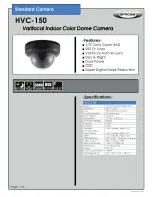
60
The specifications of the lens decisively determine the optical path of the infrared thermometer, which is
characterized by the ratio Distance to Spot size. The spectral filter selects the wavelength range, which is
relevant for the temperature measurement. The detector in cooperation with the processing electronics
transforms the emitted infrared radiation into electrical signals.
The advantages of noncontact thermometry are clear - it supports:
•
temperature measurements of moving or overheated
objects and of objects in hazardous surroundings
•
very fast response and exposure times
•
measurement without inter-reaction, no influence on the
•
measuring object
•
non-destructive measurement
•
long lasting measurement, no mechanical wear
Summary of Contents for PI 160
Page 1: ...Operator s Manual optris PI 160 200 230 400 450 450G7 640 1M Infrared camera...
Page 6: ...6 Appendix F Wiring diagrams PIF 79 Appendix G CE Conformity 83...
Page 28: ...28 Figure 7 PI400 PI450 PI450G7 PI640 PI1M dimensions mm...
Page 31: ...31 Mechanical Installation Figure 10 Cooling Jacket Dimensions...
Page 48: ...48 Figure 24 Stand Alone operation with PI Netbox Figure 25 USB Server Gigabit...
Page 52: ...52 5 2 Software window Figure 27 Software window...
Page 61: ...61 Basics of Infrared Thermometry Figure 31 Non contact thermometry...
Page 68: ...68...
Page 69: ...69 Emissivity metals Appendix A Table of emissivity for metals...
Page 70: ...70...
Page 71: ...71 Emissivity non metals Appendix B Table of emissivity for non metals...
Page 72: ...72...
Page 76: ...76...
Page 78: ...78...
Page 82: ...82 Figure 41 Relay output at industrial PIF...
Page 83: ...83 CE Conformity Appendix G CE Conformity...
Page 84: ...84...
Page 85: ...optris PI MA E2014 12 A...
















































